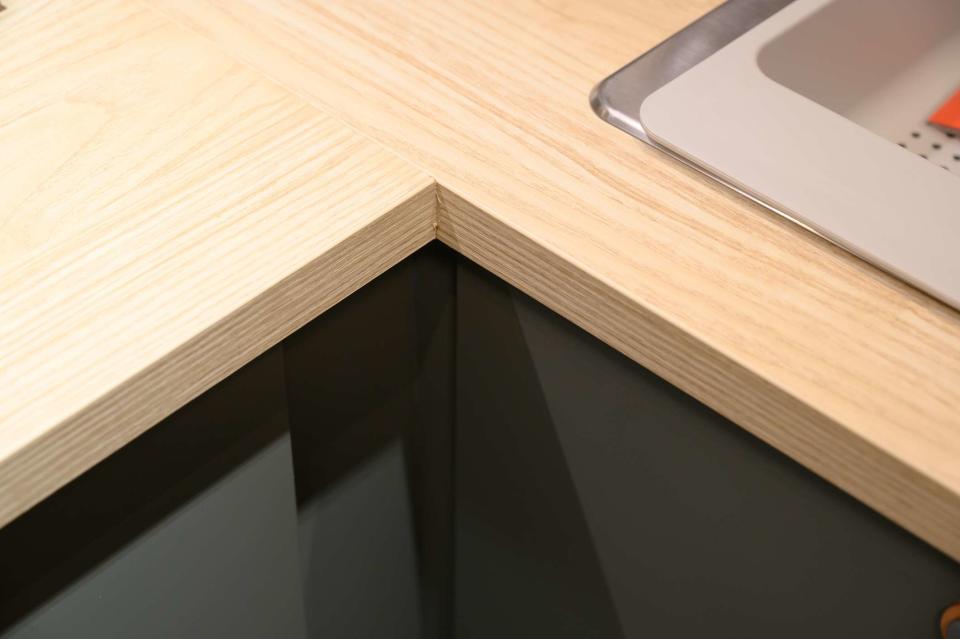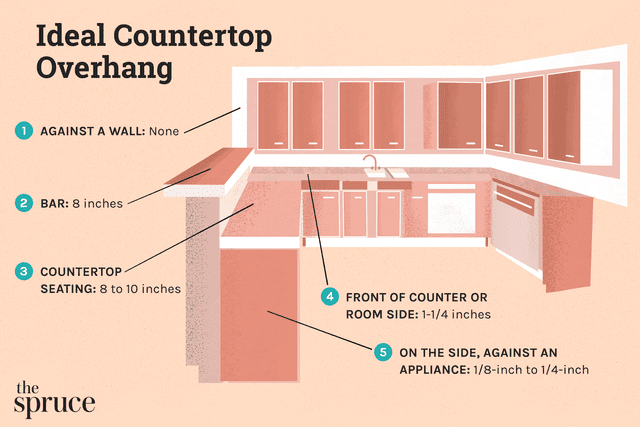How to Choose a Countertop Overhang
Standard overhang, variations, and the best way to measure

XU WU / Getty Images
Reviewed by Deane Biermeier
A countertop overhang is a measurement that sometimes comes into play before a countertop installation, making it an important piece to consider. Your choice of overhang can make a significant difference in how you can use the countertops and cabinets.
Here, we've compiled the best advice and strategies for choosing the right countertop overhang for you, including ideal countertop overhang measurements, the best way to measure, overhang kits, and more.
What Is a Countertop Overhang?
The countertop overhang is the distance from the leading edge of the countertop to the front of the base cabinets. It prevents drips from continuing down the face of the base cabinets, and it also hides the junction between the countertop and the cabinet.
Countertop overhang varies against walls, next to appliances, and for bars or countertop seating.
Countertop overhang in kitchens helps anyone standing at the counter to work more comfortably since they can get a little bit closer to their work. With countertop seating, an even greater overhang distance is needed because the user’s legs are bent while seated.
Ideal Countertop Overhang Measurements
The standard kitchen countertop overhang along the leading edge is 1 to 1 1/2 inches. That said, there are various types of layouts and types of countertop overhangs, each with different dimensions and design needs:
Countertop Section or Type | Dimension |
Front of counter or room side | 1-1/4 inches |
On the side, against an appliance | 1/8-inch to 1/4-inch |
Against a wall | No overhang |
Countertop seating | 8 to 10 inches |
Bars | 8 inches |

The Spruce / Michela Buttignol
There are various considerations for each type of countertop overhang configuration:
Front or Room Side: Most semi-custom and stock kitchen base cabinets are 24 inches deep. A standard countertop measuring 25 1/4 inches deep will leave a countertop overhang of 1 1/4 inches.
Against an Appliance: On the side, where the countertop butts against appliances such as a refrigerator, the countertop overhang should be about 1/8 inch to 1/4 inch.
Against a Wall: Where the countertop meets a wall, whether in the back or to the sides, do not add an overhang because it would create a slit that isn’t large enough to use (but large enough to collect dust).
Seating: Countertop seating must have an overhang, which should always be more than the standard. The amount of overhang is often one of preference, but it will usually be 8 inches or more. When the countertop overhang exceeds 8 to 10 inches, additional bracing will be required. An overhang of 16 to 22 inches would need vertical supports or posts.
Bar: A home bar countertop overhang is usually around 8 inches. If space is tight, you can decrease the overhang to 6 inches—but only if you expect most users to stand at the bar. Overhangs of less than 8 inches are uncomfortable.
Extended: An extended overhang is any overhang measuring more than 8 inches long. A perfect example of this type of overhang is a kitchen island that doubles as a breakfast bar, accommodating stools and legroom underneath it.
Best Way to Measure Countertop Overhang
Measuring countertop overhang is an easy process, and it uses just a tape measure, a Speed Square, or anything with a 90-degree angle, and any straight, rigid item, like a book. Here are step-by-step instructions for measuring overhang:
Put the Square on the Countertop
Rest the Speed Square or another 90-degree item, such as a box on the countertop. The room side of the square item should be flush with the edge of the countertop.
Hold a Straight Item Against the Square
Press a long, straight item, such as a book or ruler, against the square so that the long side of the straight item points downward.
Measure the Overhang
Press the end of the tape measure against the cabinet. Note the spot where the straight item meets the tape measure markings. Be sure to look at the wall side of the straight item, not the room side. This figure is your countertop overhang distance.
Tip
Whenever using a tape measure to measure against (rather than away) from an item, be sure to press firmly toward the item.
Countertop Overhang Kits for Support
To answer the question of whether your countertop overhang needs extra support, know that the proportions of the countertop matter more than the length of the overhang.
A standard rule is that the countertop overhang shouldn't exceed 30% or more of the depth of the countertop. 70% of the overhang should be supported by the cabinets underneath it.
In cases where you require more than the 30% overhang rule (i.e. kitchen islands, bar countertops, and peninsula countertops), various support options can help.
Brackets
A countertop measuring 6 inches or longer should have brackets to support it. These simply install on the underside of the countertop.
You can purchase countertop overhang kits or bracket kits online. Some good options include:
Posts
Posts are the only support option for countertop overhangs that would exceed more than 24 inches. Posts can lessen the amount of leg room available for seating, however, so keep this in mind.
Corbels
Corbels can support a countertop overhang of up to 24 inches. Corbels stick out from the wall.
Frequently Asked Questions
Is a 2-inch countertop overhang too much?
Although a standard overhang is usually 1 to 1.5 inches, a 2-inch overhang can work as long as it aesthetically fits within your design.
How much overhang do I need for countertops without support?
For kitchen countertops that do not have support, the overhang should measure less than 1/3 of the total dimension of the countertop and shouldn't exceed 15 inches.
What is the typical overhang for kitchen island seating?
For kitchen island seating, the minimum countertop overhang required would be 36 inches. In this case, you will need extra support to make this possible. Posts would be your best bet here, as these are the only support option that can support overhangs that exceed 24 inches.
Read the original article on The Spruce.

